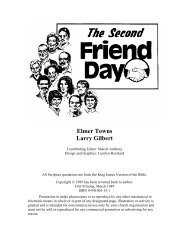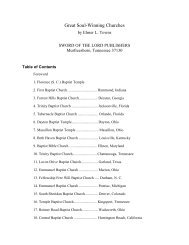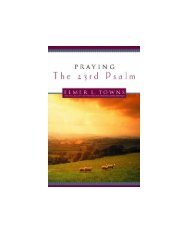PUTTING AN END TO WORSHIP WARS - Elmer Towns
PUTTING AN END TO WORSHIP WARS - Elmer Towns
PUTTING AN END TO WORSHIP WARS - Elmer Towns
- TAGS
- worship
- elmer
- towns
- elmertowns.com
You also want an ePaper? Increase the reach of your titles
YUMPU automatically turns print PDFs into web optimized ePapers that Google loves.
The Liturgical Church eagerly carries out Jesus' admonition, "The Father seeketh such to<br />
worship him" (John 4:23), the elders at Ephesus were described "As they ministered<br />
(leitourgikus, i.e. give worship to God) to the Lord" (Acts 13:2).<br />
The Congregational Church is the prescriptive ministry of God's people, "As my Father<br />
hath sent me, even so send I you" (John 20:21). Paul descriptively reflects this view, "Ye are the<br />
body of Christ, and members in particular" (I Cor. 12:27).<br />
WHY NOW?<br />
These six styles of worship or philosophies of ministries seem to have come to the<br />
surface since World War II, i.e. 1945. These worship styles were not apparent in Victorian<br />
England, Colonial America or even before World War II. Although the biblical functions have<br />
been operative since Pentecost, there has not bee a gathering of an unique biblical function in<br />
many individual churches. The influence of American Christianity as reflected in these six<br />
church paradigms was not evident in churches or groups of churches outside our borders. Also,<br />
all six qualities have been embryonic in every true church since Pentecost, it seems now that<br />
certain churches or groups of churches are characterized by a dominant trait or style, and that this<br />
strength has become the catalyst (glue) around which people gather. So why have these<br />
dominant worship types manifested themselves now in certain churches and in certain new<br />
denominations? Why now?<br />
THE INTERSTATE <strong>AN</strong>D THE INTERNET<br />
The answer lies in the impact of two explosive forces that have shaped our society in the<br />
past 50 years. These two formative factors have done to culture in general what they have done<br />
to the churches-shaped them into six groups. These two factors are (1) the Interstate freeway and<br />
(2) the Internet, i.e. computerized television screen.<br />
The Interstate highway system is a massive transportation link that joined the two coasts<br />
of America and made the shopping mall available to anyone within 25 to 50 miles. These<br />
concrete networks crisscross every state, making almost every destination available to everyone.<br />
Simply stated, the Interstate Highway represents the explosion of transportation since World War<br />
II.<br />
So now people will travel as far to church as they travel to employment or to shop. They<br />
travel 30 miles to church and never think of the distance, because church is only 30 minutes<br />
away. Whereas, the colonial farmer may have traveled one hour by wagon to get to a church that<br />
was geographically many miles closer.<br />
The Internet stands for the explosion of modern communication. People have access to<br />
almost any fact in our information processing age. Churches tell their story on cable television<br />
and local radio, in church newspapers and metro newspapers, on billboards and by various other<br />
inventive means. Everyone seems to know about the various kinds of worship in churches in<br />
their community, because they see people worshiping like this on television. Then they decide to
















